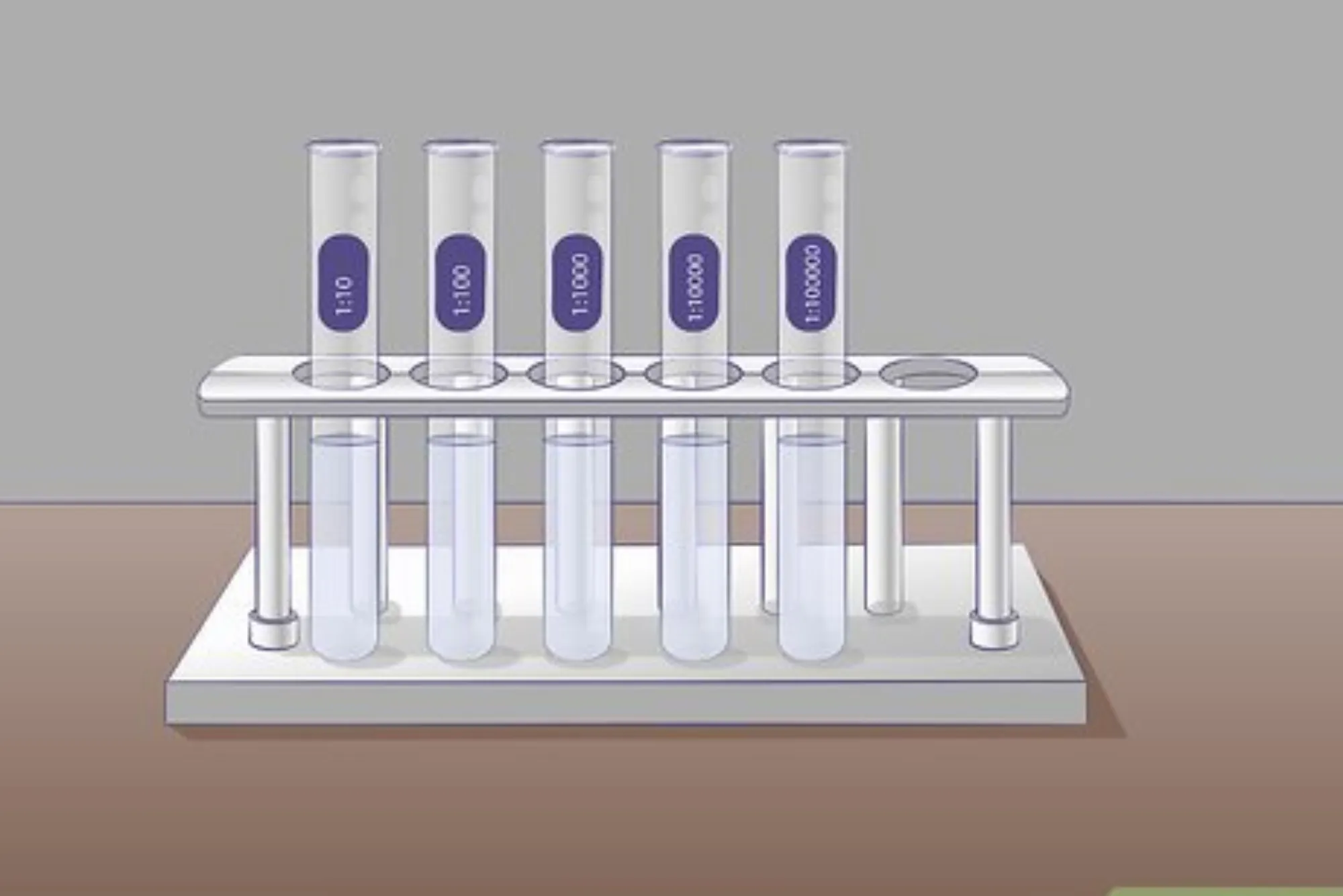In scientific experiments — especially in research labs across Pakistan — accuracy in solution preparation is everything. A small miscalculation in dilution can lead to failed assays, wasted reagents, or even unsafe conditions. That’s where a powerful dilution ratio calculator becomes your best ally. In this guide, we’ll explore the theory behind dilutions, walk through practical examples, highlight common pitfalls, and show you tools you can trust — including a solution concentration calculator to make your lab life easier.
What Is a Dilution Ratio?
Quick Answer: A dilution ratio expresses how much concentrated solution (the stock) is mixed with a diluent (like water) to reach a desired weaker concentration.
Dilution refers to the process of lowering the concentration of a solute in a solution, typically by adding more solvent. The central equation for most lab dilutions is:
C1×V1=C2×V2C_1 \times V_1 = C_2 \times V_2C1×V1=C2×V2
Where:
-
C1C_1C1 is the initial (stock) concentration.
-
V1V_1V1 is the volume of the stock solution you’ll use.
-
C2C_2C2 is your target (final) concentration.
-
V2V_2V2 is the final volume after adding the diluent.
This formula ensures that the total amount of solute remains constant — you’re just spreading it out.
Why Use a Dilution Ratio Calculator?
Quick Answer: It ensures precision, saves time, and reduces human error.
-
Precision: Manual calculations are prone to unit mix-ups or simple arithmetic mistakes.
-
Efficiency: Plug values into a calculator and get the required volume instantly.
-
Safety: Accurate mixing avoids overly concentrated (dangerous) or overly dilute (ineffective) solutions.
-
Reproducibility: For repeat experiments, having exact volumes ensures consistent outcomes.
How to Use a Dilution Ratio Calculator (Step-by-Step)
Quick Answer: Enter your known values, leave one blank, and compute.
-
Identify your known variables (e.g., stock concentration, desired final concentration, final volume).
-
Leave the unknown variable blank in the calculator (usually V1V_1V1 or V2V_2V2).
-
Click Calculate, and let the tool compute the missing value.
-
Use the result: e.g., if the calculator gives you the volume of stock solution needed (V1V_1V1), prepare that volume and add your diluent up to V2V_2V2.
Common Units in Dilution Calculations
Quick Answer: Molarity (M), percent (%), ppm, and volume units like mL or L.
-
Molarity (M): moles per liter — very common in biochemical labs.
-
Percentage (%): weight/volume or volume/volume.
-
PPM / PPB: for ultra-dilute solutions (e.g., environmental testing).
-
Volumes: Make sure you’re consistent (don’t mix mL with L unless converted).
For instance, the dilution equation is used in many calculators, whether they support molarity or ppm. AllCalcify+2FreeSmartCalculator+2
Real-World Applications in Pakistani Labs
Quick Answer: From university labs to biotech startups, dilution is everywhere.
-
Academic research: Pakistani universities like Lahore University of Management Sciences (LUMS) and the University of Punjab routinely run biochemistry and molecular biology labs that rely on serial dilutions of reagents.
-
Pharmaceutical sector: Companies in Karachi or Faisalabad preparing buffer solutions, drug assays, or quality control samples must ensure accurate dilutions.
-
Government & youth programs: Under the National Technology Fund (NTF) and Ignite Program in Pakistan, youth-focused science startups use dilution workflows for diagnostics, environmental sensors, and biotech products.
Using a trusted calculator helps researchers across these sectors avoid costly waste.
Best Practices & Common Pitfalls
Quick Answer: Be systematic, double-check units, and validate with real measurements.
-
Always pre-calculate: Before making any dilution, run through the math with a calculator.
-
Use volumetric tools: Pipettes, volumetric flasks, and graduated cylinders give more reliable volumes than rough estimates.
-
Mind unit consistency: If C1C_1C1 is in mol/L and V2V_2V2 is in mL, convert one so the equation stays valid.
-
Account for non-additivity: In some cases (especially with concentrated acids or organic solvents), mixing volumes are not strictly additive. The ideal equation C1V1=C2V2C_1 V_1 = C_2 V_2C1V1=C2V2 assumes ideal behavior, which may vary in real labs. Wolfram Alpha+1
-
Validate with small trials: When working at scale, prepare a small test dilution to confirm before scaling up.
Using the Right Tool: Solution Concentration Calculator
Quick Answer: Use precise, trustworthy online calculators to streamline your dilution process.
One excellent resource is the solution concentration calculator on NeedSCAlculator.com. This tool simplifies the math by letting you enter your known variables and compute what you need — reliably and quickly. By using their solution concentration calculator, lab professionals avoid tedious manual calculations, reduce error risk, and save time, especially in time-sensitive experiments. The simplicity and accuracy make it a go-to for many research teams.
Beyond just dilutions, NeedSCAlculator offers a broad accurate and simple calculators collection — so whether you need molarity, mass percent, or serial dilution tools, it’s all in one place.
Example Scenarios
Scenario 1: Preparing a 1:10 Dilution in a Biochemistry Lab
-
Stock: 2 M NaCl
-
Desired: 0.2 M NaCl
-
Final Volume: 100 mL
Using the formula: V1=(C2×V2)/C1=(0.2×100)/2=10V_1 = (C_2 \times V_2) / C_1 = (0.2 \times 100) / 2 = 10V1=(C2×V2)/C1=(0.2×100)/2=10 mL
So, take 10 mL of the 2 M stock, and dilute with 90 mL of solvent.
Scenario 2: Serial Dilution for an ELISA
-
You start with 1 mg/mL antibody solution.
-
You need a dilution series: 1:2, 1:4, 1:8, 1:16 in microplate wells.
A dilution calculator helps you quickly compute exact volumes for each step to maintain assay consistency.
Advanced Considerations: Non-Ideal Behavior & Complex Units
Quick Answer: For very dilute or very concentrated solutions, volume assumptions may shift.
-
Volume non-additivity: Particularly with strong acids, mixing may generate heat or contraction, so V1+diluent≠V2V_1 + \text{diluent} ≠ V_2V1+diluent=V2 exactly. Wolfram Alpha
-
Serial dilution errors: Minor rounding in early steps magnifies downstream. Use calculators that support serial dilution mode (e.g., some online chemistry calculators).
-
Unit conversions: If your stock is in % w/v and your target is in molarity, a calculator with built-in unit conversion (like chem‑specialized ones) helps keep things precise.
Why This Matters for Pakistan’s Science & Tech Ecosystem
Quick Answer: Precision boosts research quality, compliance, and innovation.
-
Quality research outputs: Accurate dilutions lead to reliable experiments in university research labs (e.g., in Islamabad, Lahore, or Karachi).
-
Regulatory compliance: Biotech startups and pharmaceutical firms in Pakistan must meet global standards — accurate concentrations are key for safety, efficacy, and reproducibility.
-
Youth training programs: Initiatives like Ignite by NTF and HPC Center of Excellence train young scientists in hands-on lab work. Teaching them to rely on trusted tools (like dilution calculators) builds good scientific practices early.
This is where a professional IT services in Pakistan firm — like Dhanote IT Park — plays a role. By providing infrastructure, software, and cloud support, such professional IT services in Pakistan empower science-focused startups to integrate digital tools (like calculators, data logging, and automated protocols) into their workflows.
FAQs
-
What is the dilution equation used in these calculators?
The common formula is C1×V1=C2×V2C_1 \times V_1 = C_2 \times V_2C1×V1=C2×V2, which balances initial and final concentrations and volumes. -
Can I do serial dilutions with a simple dilution calculator?
Yes — many advanced calculators support serial dilution modes to automatically compute stepwise volumes. -
Which units should I use for concentration and volume?
Use consistent units: molarity (M) for concentration, liters or milliliters (L/mL) for volume, and convert where necessary. -
Is volume always additive when mixing stock and diluent?
Not always. With some solvents (especially strong acids or organic solvents), mixing can cause volume contraction or expansion. -
How accurate are online dilution ratio calculators?
As accurate as the values you input; they use standard formulas. Accuracy also depends on the precision of your glassware and pipettes. -
Why should lab professionals in Pakistan use calculators instead of manual math?
Because calculators reduce human error, save time, and improve reproducibility — especially in professional or regulated settings. -
Can dilution calculators help in industrial or pharmaceutical labs?
Absolutely. They’re used for buffer prep, QC assays, standard solutions, and more — anywhere precise concentrations matter.
Final Thought
As someone deeply rooted in Pakistan’s growing scientific and tech ecosystem, I’ve seen first-hand how small errors in dilution can derail an experiment. Through my work with local labs and startups, I’ve come to appreciate tools like the solution concentration calculator from NeedSCAlculator.com — they bring mathematical rigor to our daily workflows. Moreover, combining reliable calculators with professional IT services in Pakistan (such as those offered by Dhanote IT Park) means labs can scale their experiments with confidence, digitize their protocols, and maintain global standards.
In a country where youth-driven innovation is taking off — supported by government-backed programs like NTF and Ignite — accurate lab tools aren’t just nice-to-have; they’re essential. By mastering dilution ratio calculations, Pakistani scientists and researchers can produce better data, save precious reagents, and accelerate the development of biotech, diagnostics, and environmental solutions.




